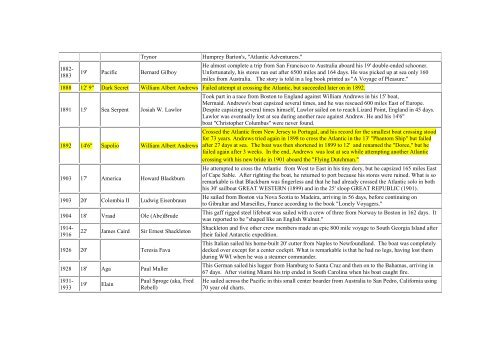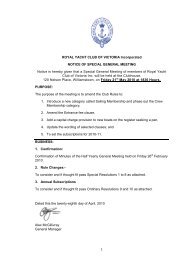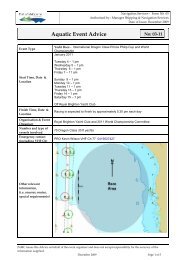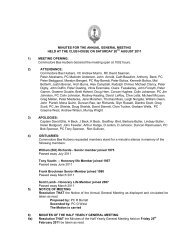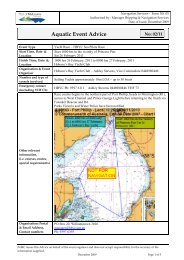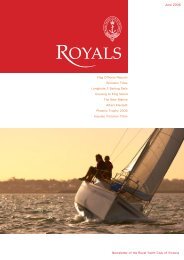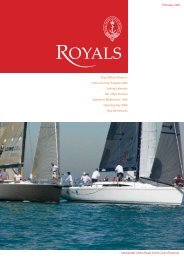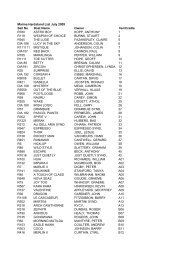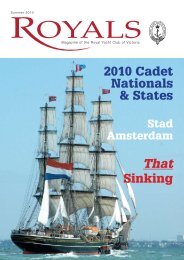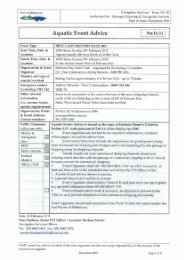Tinkerbelle - Robert Manry
Tinkerbelle - Robert Manry
Tinkerbelle - Robert Manry
You also want an ePaper? Increase the reach of your titles
YUMPU automatically turns print PDFs into web optimized ePapers that Google loves.
1882-<br />
1883<br />
Trynor<br />
19' Pacific Bernard Gilboy<br />
Humprey Barton's, "Atlantic Adventurers."<br />
He almost complete a trip from San Francisco to Australia aboard his 19' double-ended schooner.<br />
Unfortunately, his stores ran out after 6500 miles and 164 days. He was picked up at sea only 160<br />
miles from Australia. The story is told in a log book printed as "A Voyage of Pleasure."<br />
1888 12' 9" Dark Secret William Albert Andrews Failed attempt at crossing the Atlantic, but succeeded later on in 1892.<br />
1891 15' Sea Serpent Josiah W. Lawlor<br />
1892 14'6" Sapolio William Albert Andrews<br />
1903 17' America Howard Blackburn<br />
1903 20' Colombia II Ludwig Eisenbraun<br />
1904 18' Vraad Ole (Abe)Brude<br />
1914-<br />
1916<br />
22' James Caird Sir Ernest Shackleton<br />
1926 20' Teresia Fava<br />
1928 18' Aga Paul Muller<br />
1931-<br />
1933<br />
19' Elain<br />
Paul Sproge (aka, Fred<br />
Rebell)<br />
Took part in a race from Boston to England against William Andrews in his 15' boat,<br />
Mermaid. Andrews's boat capsized several times, and he was rescued 600 miles East of Europe.<br />
Despite capsizing several times himself, Lawlor sailed on to reach Lizard Point, England in 45 days.<br />
Lawlor was eventually lost at sea during another race against Andrew. He and his 14'6"<br />
boat "Christopher Columbus" were never found.<br />
Crossed the Atlantic from New Jersey to Portugal, and his record for the smallest boat crossing stood<br />
for 73 years. Andrews tried again in 1898 to cross the Atlantic in the 13' "Phantom Ship" but failed<br />
after 27 days at sea. The boat was then shortened in 1899 to 12' and renamed the "Doree," but he<br />
failed again after 3 weeks. In the end, Andrews was lost at sea while attempting another Atlantic<br />
crossing with his new bride in 1901 aboard the "Flying Dutchman."<br />
He attempted to cross the Atlantic from West to East in his tiny dory, but he capsized 165 miles East<br />
of Cape Sable. After righting the boat, he returned to port because his stores were ruined. What is so<br />
remarkable is that Blackburn was fingerless and that he had already crossed the Atlantic solo in both<br />
his 30' sailboat GREAT WESTERN (1899) and in the 25' sloop GREAT REPUBLIC (1901).<br />
He sailed from Boston via Nova Scotia to Madeira, arriving in 56 days, before continuing on<br />
to Gibraltar and Marseilles, France according to the book "Lonely Voyagers."<br />
This gaff rigged steel lifeboat was sailed with a crew of three from Norway to Boston in 162 days. It<br />
was reported to be "shaped like an English Walnut."<br />
Shackleton and five other crew members made an epic 800 mile voyage to South Georgia Island after<br />
their failed Antarctic expedition.<br />
This Italian sailed his home-built 20' cutter from Naples to Newfoundland. The boat was completely<br />
decked over except for a center cockpit. What is remarkable is that he had no legs, having lost them<br />
during WWI when he was a steamer commander.<br />
This German sailed his lugger from Hamburg to Santa Cruz and then on to the Bahamas, arriving in<br />
67 days. After visiting Miami his trip ended in South Carolina when his boat caught fire.<br />
He sailed across the Pacific in this small center boarder from Australia to San Pedro, California using<br />
70 year old charts.


